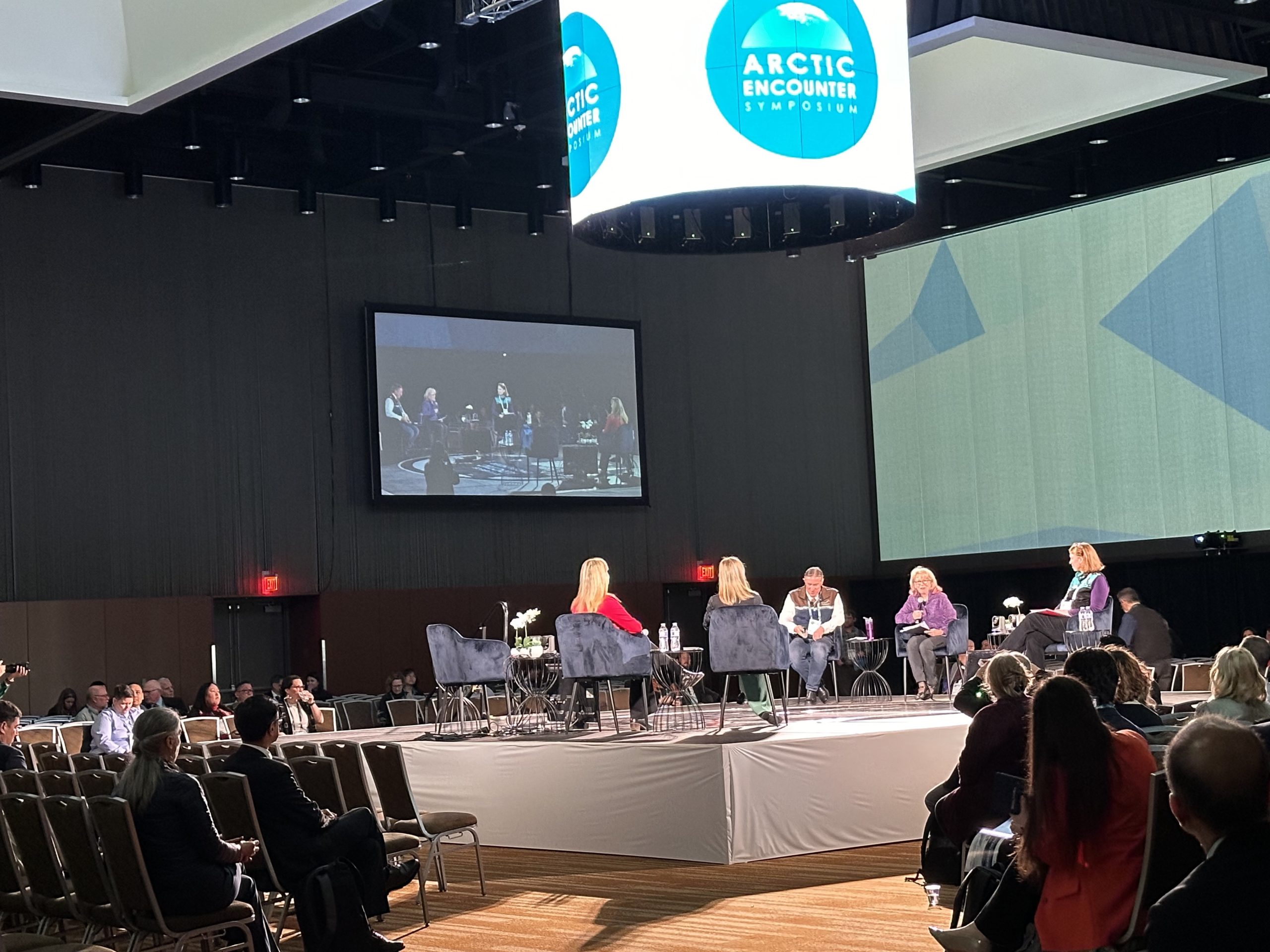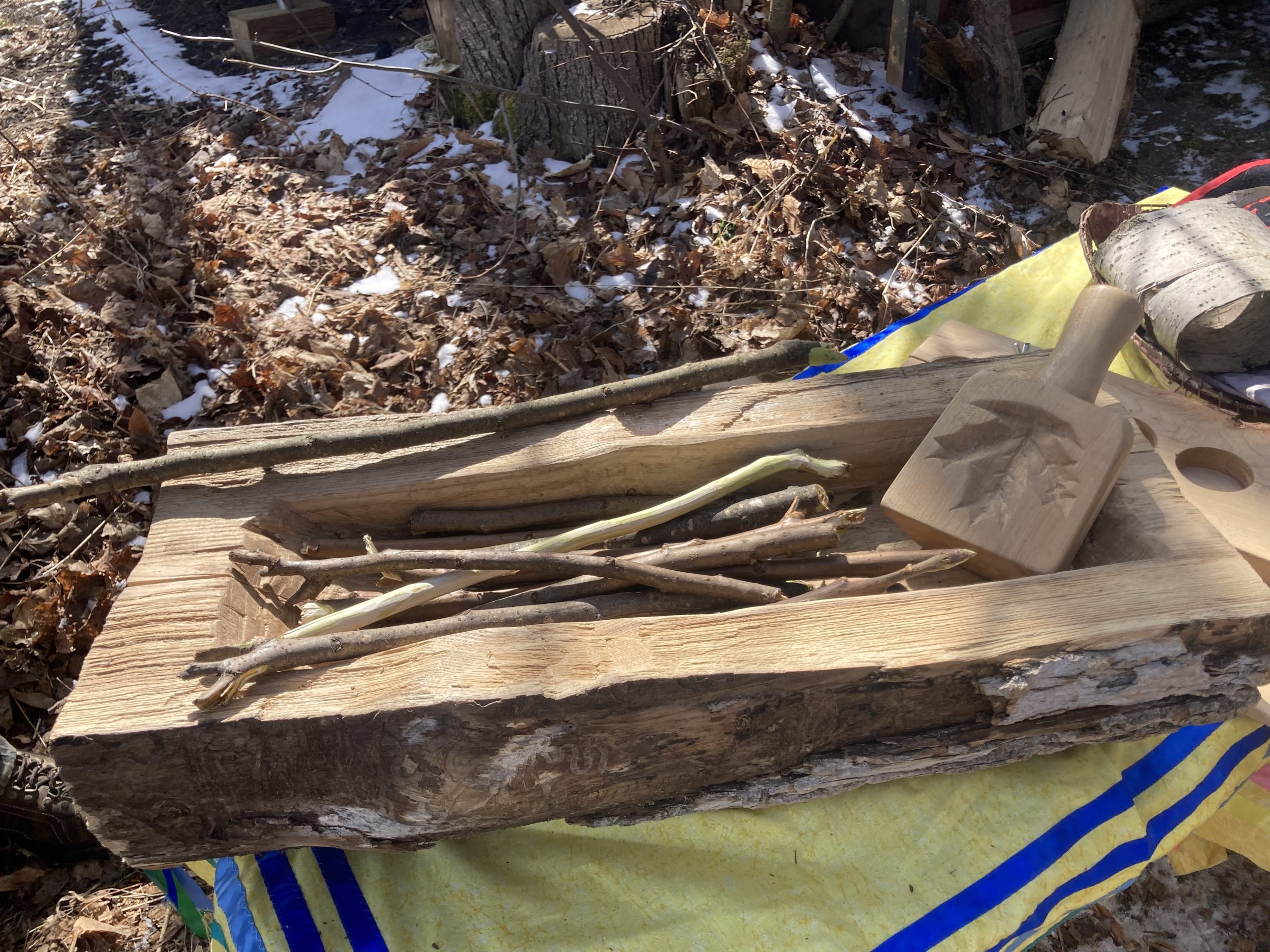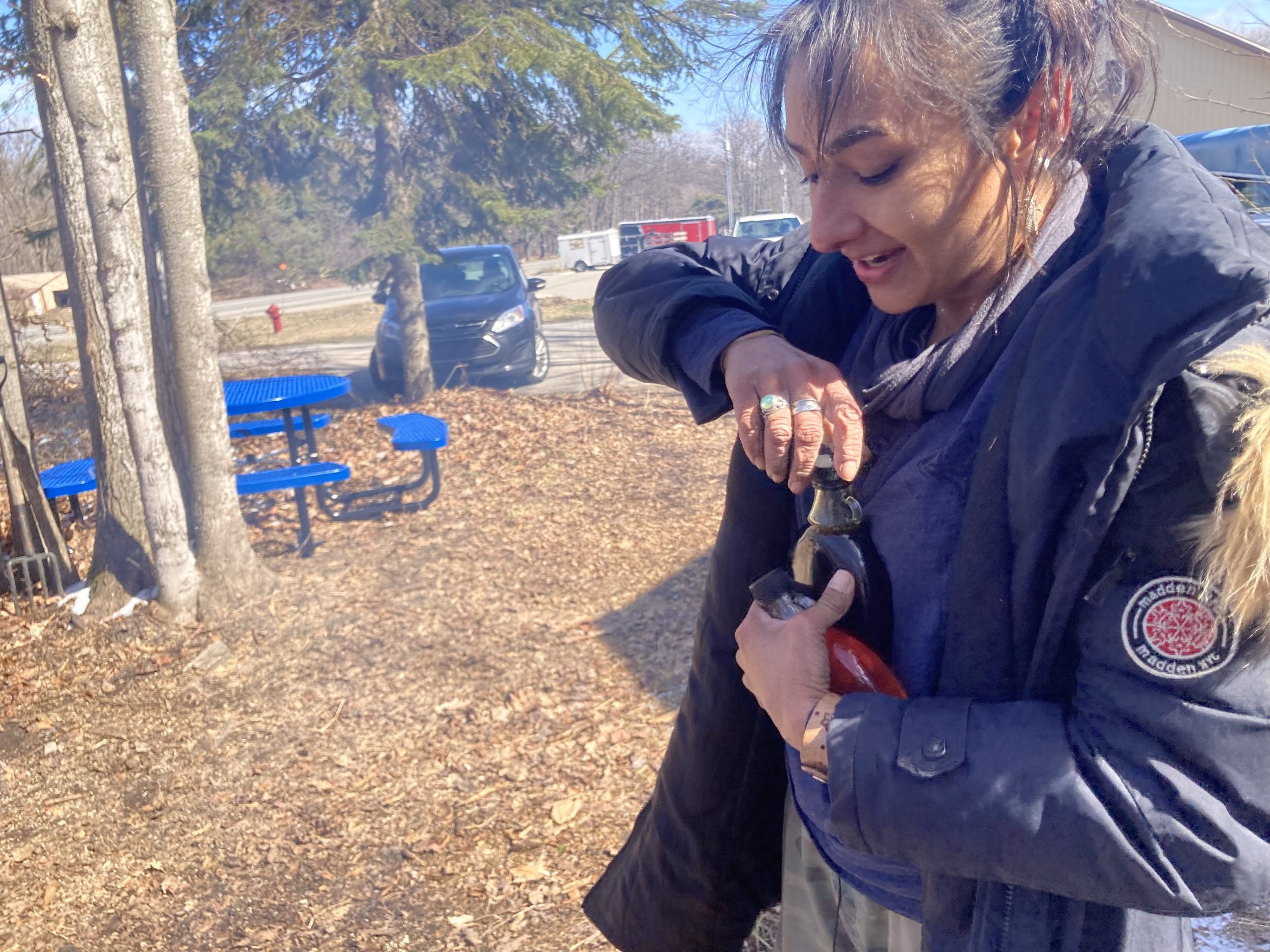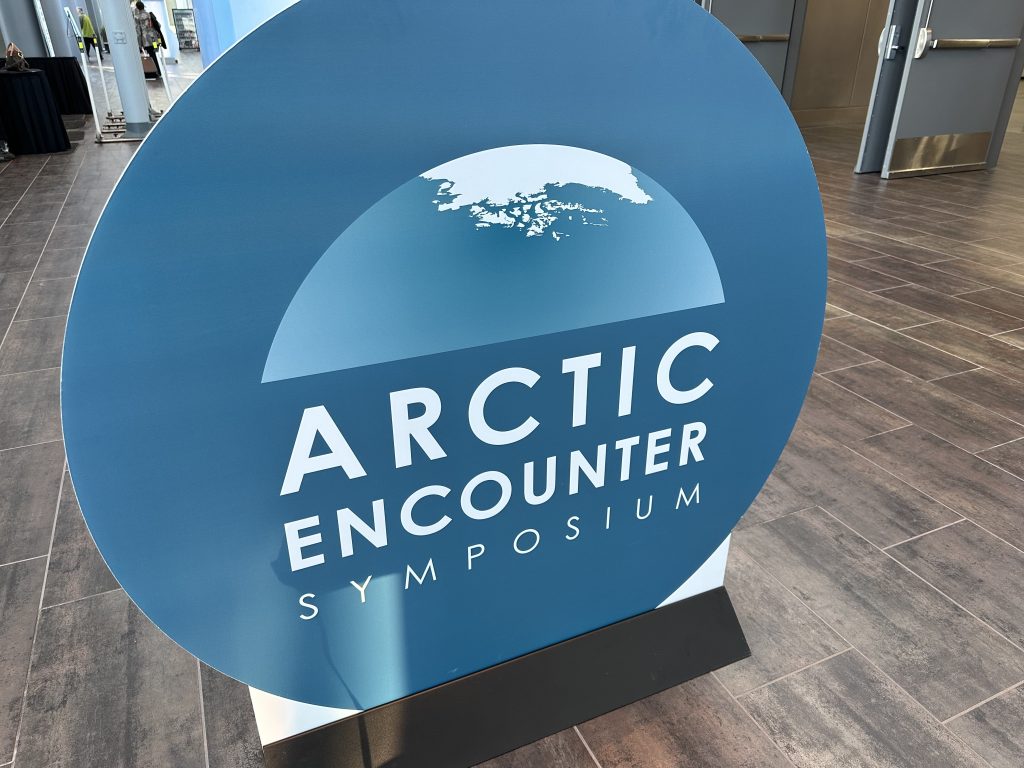Podcast: Play in new window | Download | Embed
Dignitaries, high ranking military officials, and Indigenous leaders from across the Arctic are in Anchorage this week.
As KYUK’s Emily Schwing reports, they’re here for the annual Arctic Encounter Symposium – the largest annual Arctic policy-focused gathering in the United States.
Pearl Brower is the President and CEO of the Ukpeagvik Iñupiat Corporation (UIC).
She says the people who live every day in the Arctic should be the focus beyond this week’s discussions.
“When you’re thinking about the Arctic while you’re here, think about us, think about the people and that’s, I think, really the key critical component. As policy makers, as people working within the region, thinking about the arctic, we think about the people first, because that’s what it’s all about.”

(Photo: Antonia Gonzales)
Brower, who is from Utqiaġvik, was among six Indigenous leaders from across the state who took to the main stage at Anchorage’s Dena’ina Civic and Convention Center to kick off this year’s symposium with a conversation about their visions for success into the future.
Roy Algoinga grew up in White Mountain. He was recently named the President and CEO of the First Alaskans Institute, a policy and advocacy non-profit organization that also focuses on building leadership skills among Alaska Native youth. He says any future success must include younger generations.
“I look at our youth as the starting point of new discussion of change, of functionality of being capable to move forward with all of the things that we need in our community.”
Among the long list of topics on the Arctic Encounter agenda this week are discussions on sustainable energy, infrastructure investments, and emergency preparedness in the Arctic.
Jill Fratis from our flagship station KNBA spoke with some Arctic Encounter attendees about top priorities facing their regions, as speakers Wednesday from around the world discussed topics such as Arctic energy investments, and climate change, something a majority of attendees, especially in Alaska say they are impacted by.
Britt’nee Brower from Utgiagvik, formerly known as Barrow, says growing up, the land was lush, and spread out.
As the years went by, she noticed many changes due to climate change.
“There’s been a lot of changes going on in Barrow in terms of the beach. We’ve had a lot of roads wash out these days, to where we don’t have a road anymore, and you have to travel by ATV or ski-doo.”
Brower says that while there have been projects in the past to try to rebuild the roads after the erosion, it’s short lived.
As far as hunting, she says hunters are struggling.
“Over the past 20 years that I’ve witnessed we’ve lost a lot of our beach. I think some of the hunters have to go further out with the ice and the walrus.”
Emmalina Gayayok is from Togiak, and while erosion is also a problem in her village, the berries too have taken a hit.
“Our rivers that laid out to the ocean also changed drastically, and our berries on the tundra kind of dried up, and they’re really scarce.”
Arctic regions are disproportionately impacted by climate warming at twice the rate of non-Arctic regions, according to the Arctic Encounter.
Speakers in the afternoon consisted of scientists, ambassadors, and senior advisors.
They discussed the future of the climate and how to navigate the changes happening in such a rapid pace.
Brower worries about what will happen when the permafrost continues to melt, and for the future of her community, but she says they will always work together to roll with the tide.
“I feel like within the community, I’m sure we can adapt to changes. I feel like we’ve been doing that for years now.”
The Arctic Encounter continues through Friday.
LISTEN to this Arctic Encounter web extra from NNN anchor Antonia Gonzales and NNN reporter Rhonda LeValdo

O. Patricia Lekanoff Gregory, Board Vice President, Aleut International Association

The Anishinaabeg have a long history of harvesting maple sap, then processing it into syrup and sugar. Traditional technology included sumac branches used as spiles, pictured here, which would be tapped into trees. A paddle is used to work the sap down to sugar over heat. (Photo: Ellie Katz / IPR News)
Several Anishinaabe tribes in northern Michigan decided not to tap their maple trees this spring after an unusually mild winter.
The Grand Traverse Band of Ottawa and Chippewa Indians is one of those tribes who’ve decided to let their trees rest. Despite that, the band was able to continue with parts of the tradition at their sugar shack, using maple sap that had been saved or traded for.
Interlochen Public Radio’s Ellie Katz spoke with Tera John, who works on restoring traditional foodways and food sovereignty for the Grand Traverse Band.
Kathleen Smith works for the Great Lakes Indian Fish and Wildlife Commission, which represents eleven Ojibwe tribes in Minnesota, Wisconsin, and Michigan.
Smith, whose title in Anishinaabemowin is ganawandang manoomin, or “she who takes care of the wild rice,” does a lot of work with traditional foods in the upper Great Lakes. And she says some places went ahead with sugar bush.
“The areas where I have harvested and helped, the sugar bushes, they’re doing quite well. They were offering themselves up.”
Smith is a member of the Keweenaw Bay Indian Community.
She’s helped out with sugar bush in a few places in the Upper Peninsula of Michigan and northern Wisconsin this year, where she says they had signs to harvest, like heavy snowpack over the winter and good freeze-and-thaw conditions in early spring.
But with steadily warming winters plus challenges like disease and pests, Smith says it will become more and more important for tribal communities across the Great Lakes to talk with each other and keep rebuilding foodways and traditions.
“So for instance, like the black ash [tree and] the emerald ash borer … we had relatives downstate that were asking us for black ash, since we didn’t have [the borer] yet. I think it’s important that communities that still have sap running – maybe we could trade for something later on. Because we need to bring that back, we need to be able to help our relatives out as well, that weren’t able to do sugar bush.”
Back at the sugar shack in Peshawbestown, Tera John pulls out a few bottles of maple syrup harvested nearby that she was able to trade for.
She pours the liquid into a cast iron pot over the fire and starts stirring.
“I’m boiling it down. I’m going to sugar this.”
After several hours of careful stirring, the syrup will thicken, eventually reducing down to a granular, golden-brown sugar.
John has led a few sugar bush workshops like this one to teach tribal and non-tribal community members about the tradition. And the band’s agriculture department says they’re aiming to tap 600 trees next year, up from around 300 last year.
They’ve invested in new equipment and home tree-tapping kits to give out to families, thanks in part to a big grant aimed at reinvigorating food traditions for tribal members.

Tera John opens a bottle of syrup. Though the band’s agriculture department decided to let the trees rest this year, John is still leading sugarbush workshops to teach tribal and non-tribal community members about the tradition. The workshops, along with new sugaring equipment and at-home tapping kits for families, are thanks in part to a grant the band is using to reinvigorate food traditions for tribal members. (Photo: Ellie Katz / IPR News)
Later in the afternoon, the sun comes out and more people have joined around the fire.
John says this – the act of showing up to sugar bush with intention, being outside the sugar shack and near the ininaatigoog, the sugar maples – is vital during this year of rest, for the people and the trees.
“I’m going to sugar this down and show these guys that I mean business to take care of them. This is what I’m intending for them – to occupy this space throughout the year, to host workshops, or harvesting, or teachings, storytellings right here so we can live life with these guys.
“They miss our laughter, and our arguing, and our kids running around. They’re supposed to be part of our lives … we’re coming back. We’ll learn how.”
Get National Native News delivered to your inbox daily and stay up-to-date on the 2024 Native Vote. Sign up for our daily newsletter today.
